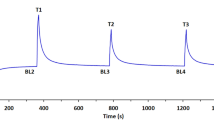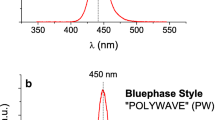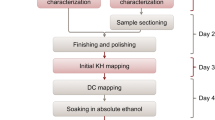Abstract
Recent reports claim that modern light-emitting diode (LED) curing units improve curing efficiency by increasing the units' irradiance. In this context also, short polymerisation times up to 5 s are proposed. The aim of this study was to examine whether there are differences in the curing efficiency of modern LED curing units by assessing their effect on two different composite materials and by varying the irradiation time. A nano- and a micro-hybrid resin-based composite (RBC) were polymerised for 5, 10 and 20 s with three commercial and a Prototype LED unit (Elipar™ S10). Cylindrical specimens (6 mm in depth, 4 mm in diameter) were prepared in three increments, each 2-mm thick, and were consecutively cured. Degree of cure was measured for 20 min in real time at the bottom of the samples, starting with the photoinitiation. The micro-mechanical properties (modulus of elasticity, E and Vickers hardness, HV) were measured as a function of depth, in 100-μm steps, on the above described samples stored in distilled water for 24 h at 37°C. Data were analysed with multivariate ANOVA followed by Tukey's test, t test and partial eta-squared statistics. In descending order of the strength of their effect, the type of RBC, depth, polymerisation time and curing unit were significant factors affecting the micro-mechanical parameters (p < 0.05). The degree of cure at 6-mm depth was less but significantly influenced by the curing unit and curing time and was independent from the type of RBC. A 5-s irradiation time is not recommended for these units. Whereas a 5-s irradiation is acceptable at the sample's surface, a minimum of 20 s of irradiation is necessary for an adequate polymerisation 2 mm beyond the surface.




Similar content being viewed by others
References
Aravamudhan K, Floyd CJ, Rakowski D, Flaim G, Dickens SH, Eichmiller FC et al (2006) Light-emitting diode curing light irradiance and polymerization of resin-based composite. J Am Dent Assoc 137:213–223
Yearn JA (1985) Factors affecting cure of visible light activated composites. Int Dent J 35:218–225
Musanje L, Darvell BW (2006) Curing-light attenuation in filled-resin restorative materials. Dent Mater 22:804–817
Ferracane JL (1995) Current trends in dental composites. Crit Rev Oral Biol Med 6:302–318
Mitra SB, Wu D, Holmes BN (2003) An application of nanotechnology in advanced dental materials. J Am Dent Assoc 134:1382–1390
Ilie N, Hickel R (2009) Investigations on mechanical behaviour of dental composites. Clin Oral Investig 13:427–438
Rueggeberg F (1999) Contemporary issues in photocuring. Compend Contin Educ Dent Suppl 25:S4–S15, Quiz S73
Hammesfahr PD, O'Connor MT, Wang X (2002) Light-curing technology: past, present, and future. Compend Contin Educ Dent 23:18–24
Neumann MG, Miranda WG Jr, Schmitt CC, Rueggeberg FA, Correa IC (2005) Molar extinction coefficients and the photon absorption efficiency of dental photoinitiators and light curing units. J Dent 33:525–532
Caughman WF, Rueggeberg FA, Curtis JW Jr (1995) Clinical guidelines for photocuring restorative resins. J Am Dent Assoc 126:1280–1282, 1284, 1286
Rueggeberg FA, Caughman WF, Curtis JW Jr, Davis HC (1993) Factors affecting cure at depths within light-activated resin composites. Am J Dent 6:91–95
Halvorson RH, Erickson RL, Davidson CL (2002) Energy dependent polymerization of resin-based composite. Dent Mater 18:463–469
Musanje L, Darvell BW (2003) Polymerization of resin composite restorative materials: exposure reciprocity. Dent Mater 19:531–541
Schattenberg A, Lichtenberg D, Stender E, Willershausen B, Ernst CP (2008) Minimal exposure time of different LED-curing devices. Dent Mater 24:1043–1049
Ilie N, Kunzelmann KH, Visvanathan A, Hickel R (2005) Curing behavior of a nanocomposite as a function of polymerization procedure. Dent Mater J 24:469–477
Rueggeberg FA, Ergle JW, Mettenburg DJ (2000) Polymerization depths of contemporary light-curing units using microhardness. J Esthet Dent 12:340–349
Hartung M, Wastian C (2003) Effects of different light guides on the depth of cure. J Dent Ress Issue 82, Spec Iss Letter B, Poster No 1499
DIN-50359-1 (1997) Testing of metallic materials–universal hardness test–part 1: test method
Fischer-Cripps AC (2004) Nanoindentation: dynamic indentation testing. Springer, Berlin
Ilie N, Hickel R (2009) Macro-, micro- and nano-mechanical investigations on silorane and methacrylate-based composites. Dent Mater 25:810–819
Vaidyanathan J, Vaidyanathan TK, Wang Y, Viswanadhan T (1992) Thermoanalytical characterization of visible light cure dental composites. J Oral Rehabil 19:49–64
Silikas N, Eliades G, Watts DC (2000) Light intensity effects on resin-composite degree of conversion and shrinkage strain. Dent Mater 16:292–296
Franz A, Konig F, Anglmayer M, Rausch-Fan X, Gille G, Rausch WD et al (2003) Cytotoxic effects of packable and nonpackable dental composites. Dent Mater 19:382–392
Munksgaard EC, Peutzfeldt A, Asmussen E (2000) Elution of TEGDMA and BisGMA from a resin and a resin composite cured with halogen or plasma light. Eur J Oral Sci 108:341–345
Lien W, Vandewalle KS (2010) Physical properties of a new silorane-based restorative system. Dent Mater 26:337–344
Curtis AR, Shortall AC, Marquis PM, Palin WM (2008) Water uptake and strength characteristics of a nanofilled resin-based composite. J Dent 36:186–193
Lin L, Drummond JL (2010) Cyclic loading of notched dental composite specimens. Dent Mater 26:207–214
Curtis AR, Palin WM, Fleming GJ, Shortall AC, Marquis PM (2009) The mechanical properties of nanofilled resin-based composites: characterizing discrete filler particles and agglomerates using a micromanipulation technique. Dent Mater 25:180–187
Curtis AR, Palin WM, Fleming GJ, Shortall AC, Marquis PM (2009) The mechanical properties of nanofilled resin-based composites: the impact of dry and wet cyclic pre-loading on bi-axial flexure strength. Dent Mater 25:188–197
Conflict of interest
The authors declare that they have no conflict of interest.
Author information
Authors and Affiliations
Corresponding author
Rights and permissions
About this article
Cite this article
Rencz, A., Hickel, R. & Ilie, N. Curing efficiency of modern LED units. Clin Oral Invest 16, 173–179 (2012). https://doi.org/10.1007/s00784-010-0498-3
Received:
Accepted:
Published:
Issue Date:
DOI: https://doi.org/10.1007/s00784-010-0498-3




